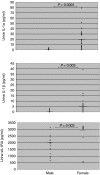Strikingly higher interleukin (IL)-1alpha, IL-1beta and soluble interleukin-1 receptor antagonist (sIL-1RA) but similar IL-2, sIL-2R, IL-3, IL-4, IL-6, sIL-6R, IL-10, tumour necrosis factor (TNF)-alpha, transforming growth factor (TGF)-beta and interferon IFN-gamma urine levels in healthy females compared to healthy males: protection against urinary tract injury?
- PMID: 16232218
- PMCID: PMC1809507
- DOI: 10.1111/j.1365-2249.2005.02924.x
Strikingly higher interleukin (IL)-1alpha, IL-1beta and soluble interleukin-1 receptor antagonist (sIL-1RA) but similar IL-2, sIL-2R, IL-3, IL-4, IL-6, sIL-6R, IL-10, tumour necrosis factor (TNF)-alpha, transforming growth factor (TGF)-beta and interferon IFN-gamma urine levels in healthy females compared to healthy males: protection against urinary tract injury?
Abstract
The aim of this prospective study was to examine gender-related differences of cytokines in the plasma and urine of healthy individuals that might provide a clue concerning the lower rate of chronic renal diseases in females. Soluble interleukin-1 receptor antagonist (sIL-1RA), interleukin (IL)-1alpha, IL-1beta, IL-2, sIL-2R, IL-3, IL-4, IL-6, sIL-6R, IL-10, tumor necrosis factor (TNF)-alpha, transforming growth factor (TGF)-beta(2) and interferon (IFN)-gamma were determined using standard enzyme-linked immunosorbent assay (ELISA). Cytokine levels were determined in simultaneously obtained plasma and urine samples of 18 male and 28 female healthy members of our laboratory staff. Urine cytokine levels were studied three times at 1-month intervals. All individuals had a negative urine nitrite test and showed no symptoms of urinary tract infection (UTI). Plasma levels of all studied cytokines were similar in males and females (P = n.s.). However, females had significantly higher urine IL-1alpha (P < 0.0001; P < 0.0001; P < 0.0001) and sIL-1RA (P = 0.0001; P = 0.0003; P = 0.0002) than males at three and higher IL-1beta at one of the three investigations (P = 0.098; P = 0.003; P = 0.073). Urine levels of the other cytokines were similar in males and females. Higher urine levels of IL-1alpha, IL-1beta and sIL-1RA in females may result from stimulation of cells in the urinary tract. Increased sIL-1RA might block T lymphocyte activation. The elevated cytokines may play a role in the protection of the female urinary tract from certain renal diseases, such as pyelonephritis and other inflammatory and sclerotic kidney diseases.
Figures

References
-
- Gandolfo MT, Verzola D, Salvatore F, et al. Gender and the progression of chronic renal diseases: does apoptosis make the difference? Minerva Urol Nefrol. 2004;56:1–14. - PubMed
-
- Silbiger SR, Neugarten J. The role of gender in the progression of renal disease. Adv Ren Replace Ther. 2003;10:3–14. - PubMed
-
- Foxman B. Epidemiology of urinary tract infections: incidence, morbidity, and economic costs. Dis Mon. 2003;49:53–70. - PubMed
-
- Lynch EA, Dinarello CA, Cannon JG. Gender differences in IL-1 alpha, IL-1 beta, and IL-1 receptor antagonist secretion from mononuclear cells and urinary excretion. J Immunol. 1994;153:300–6. - PubMed
-
- Rauta V, Teppo AM, Tornroth T, Honkanen E, Gronhagen-Riska C. Lower urinary-interleukin-1 receptor-antagonist excretion in IgA nephropathy than in Henoch–Schonlein nephritis. Nephrol Dial Transplant. 2003;18:1785–91. - PubMed
MeSH terms
Substances
LinkOut - more resources
Full Text Sources
Other Literature Sources
Medical
Miscellaneous

